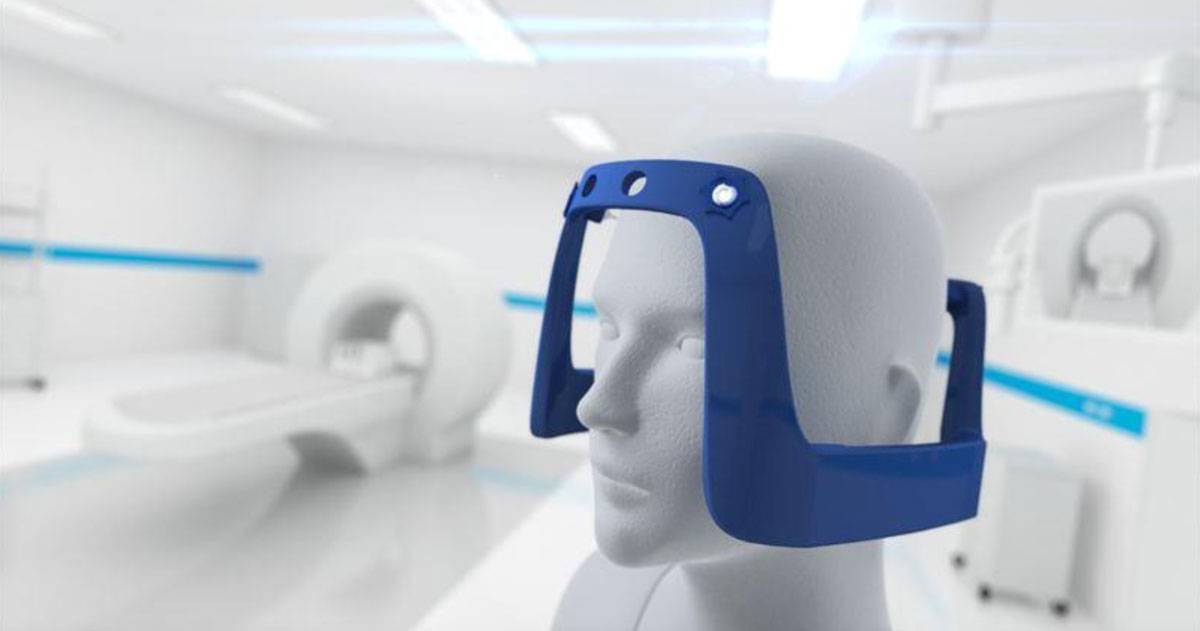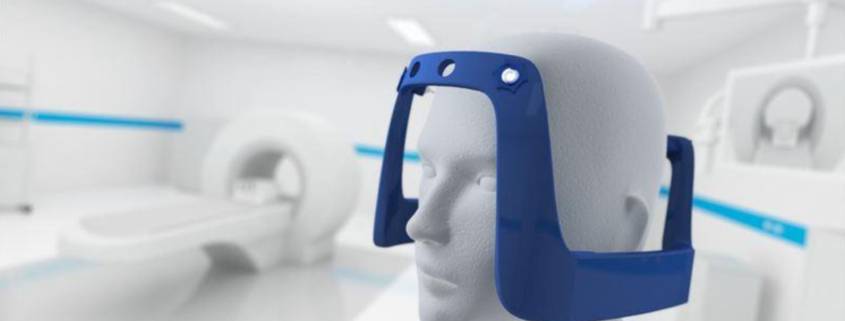What is Gamma Knife® and how does it work?
Gamma Knife® is a system of highly accurate, focused delivery of radiotherapy, performed during a day visit, for a number of benign and malignant brain tumours, among other indications. Despite its name, there is no actual “knife” involved and therefore there is no open surgery. In contrast to radiotherapy, Gamma Knife® is delivered usually through a single fraction and there is no need for repeated treatments over weeks.
The process involves four steps:
- First, application of a frame resembling a helmet.
- Second, a high resolution, detailed MRI brain scan with the frame on.
- Third, visualisation, planning and targeting of the lesion(s) using an advanced planning software.
- Fourth, the delivery of treatment using one of the latest Gamma Knife® models that resemble a scanner. Some more practical details for these steps are below.

Image 1 – The latest Leksell Vantage TM Frame is a major improvement in Gamma Knife® treatments flow as it is light, made from non-metallic glass fibre reinforced epoxy. It is patient-friendly, unobstructive to the face but also allows faster MR image acquisition, up to 50%, with less distortion or artefacts. (Image courtesy of Elekta)
The frame is secured onto the skull with four small pins after local anaesthetic numbs the skull. The patient feels some pressure but not sharp pain. At Queen Square Radiosurgery Centre, we now have the option to use the latest frame model called Vantage TM (Image 1). It is light, does not obstruct the face, and allows faster scanning with fewer artefacts. After planning, the patient lies flat on the Gamma Knife® machine (Image 2). The process is painless, similar to having an x-ray. The duration of the treatment varies, based on the size of the lesion(s) and the number of the lesions, but is typically between 1-2 hours, and is generally tolerated very well.

Image 2 – The Gamma Knife® Perfexion TM. The patient lies comfortably on the table while the treatment is delivered painlessly to the lesions. (Image courtesy of Elekta)
What are the benefits of using Gamma Knife® for brain metastases treatment?
Surgery is typically reserved for larger, single lesions. Gamma Knife®® however, can be used for patients that have more than one lesions, often apart in the brain or in both sides of the brain. Also lesions deep in the brain or close to very sensitive structures can be targeted effectively with Gamma Knife®. Compared to open surgery there is no need for hospital admission or general anaesthesia. Following Gamma Knife® treatment, the frame is removed, and patients can go home within an hour of completing their treatment.
How effective is Gamma Knife® in treating brain metastasis compared to other treatments?
There is vast worldwide experience in treating brain metastases with Gamma Knife®, possibly more than any other type of lesions or tumours. For metrics like overall survival and progression free survival the results are comparable to open surgery. In addition, following open surgery for large, single metastases we now use Gamma Knife® to boost the surgical cavity, thereby delaying recurrences.
Compared to whole brain radiotherapy, Gamma Knife® offers better outcomes. Also avoids brain toxicity and side effects such as cognitive decline observed in groups of patients undergoing whole brain radiotherapy.
Chemotherapy options are generally less effective for brain metastases as the brain has a unique protection system called blood-brain barrier that does not allow chemotherapy to reach tumours within the brain.
What are the risks and side effects of Gamma Knife® treatment for brain metastasis?
Side effects are rare and include infection or bruising of the scalp from the pin sites, local brain swelling that can be mitigated with a short course of oral steroids. More rare risks include haematoma, stroke or seizures. In fact, patients are not allowed to drive for a month following Gamma Knife®.
A well described complication following Gamma Knife® is radiation-induced necrosis. As the photons targeting and kill the metastases, there might be a reaction where the tumour cells die, but continue to upset the brain producing swelling. This complication occurs in approximately 3% of patients. However, as patients survive longer this risk may reach 5% or 10% in patients surviving 3 years or longer.
Is Gamma Knife® treatment suitable for all patients with brain metastasis?
Not all patients with brain metastases are suitable for Gamma Knife®. This depends on the number of brain lesions, the size and location of each lesion, the primary cancer, the severity and spread of the primary cancer, and how well the patient feels and performs in daily activities.
Each case needs to be discussed with an experienced surgeon who has both surgical and Gamma Knife® expertise. In addition, all cases are discussed at a large multidisciplinary team meeting, and the suitability of each patient is examined by a group of specialists including surgeons, Gamma Knife® practitioners, neuroradiologists, and physicists.
The Gamma Knife® radiosurgery centre at Queen Square employs state of the art technology, including the latest Vantage TM frame and operates a large, weekly multidisciplinary meeting where all potential cases are discussed comprehensively.

Mr Samandouras
Consultant Neurosurgeon, Queen Square
Available to discuss treatment options with patients harbouring brain metastases and can be reached here.



